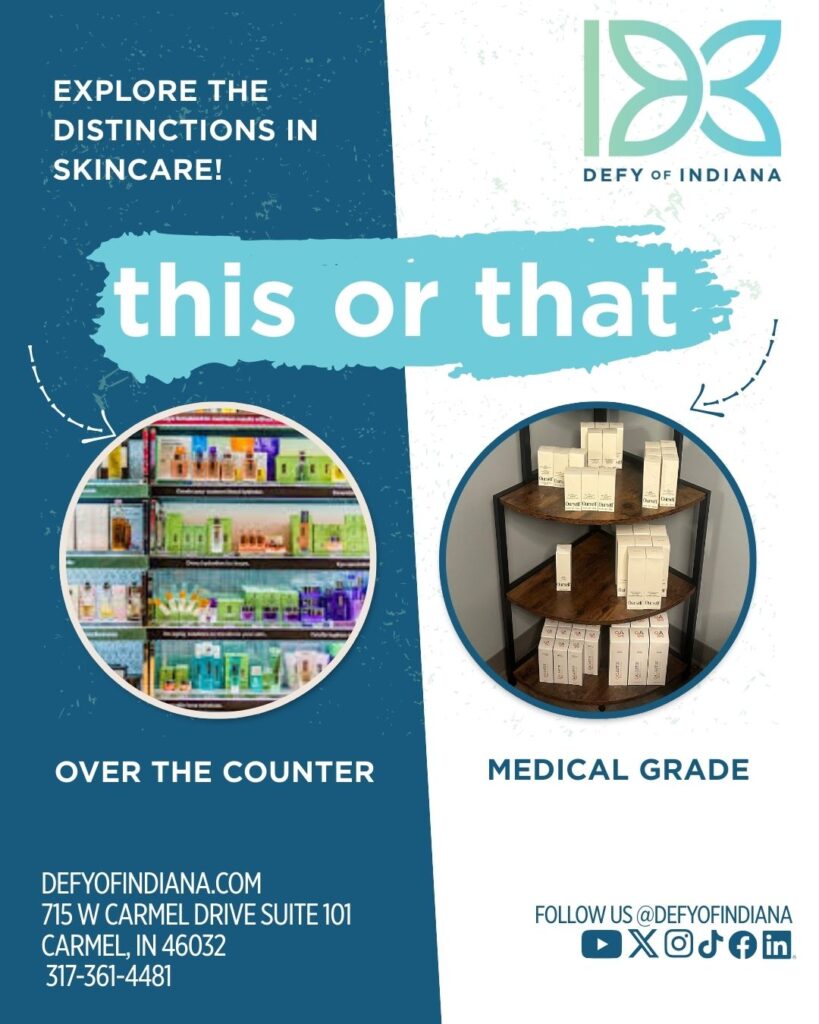When it comes to skincare, the shelves at drugstores and beauty retailers are overflowing with products that promise younger, healthier, and glowing skin. But not all skincare is created equal. And the difference between medical-grade and over-the-counter (OTC) products can be dramatic.

At first glance, OTC products may seem more affordable. However, when you compare concentration of active ingredients, scientific formulation, and clinical testing, medical-grade skincare often delivers more noticeable, long-term results. They could even save money over time by targeting concerns more effectively.
Understanding “Medical Grade” Skincare
Medical-grade skincare, also called cosmeceuticals, contains higher concentrations of active ingredients than OTC products, often at levels that can only be dispensed through a licensed provider such as a dermatologist, plastic surgeon, or medical spa.
These products are formulated to penetrate deeper into the skin (down to the dermis), where collagen production, pigmentation changes, and most skin damage occurs. They’re backed by clinical studies proving efficacy and safety. The ingredients are delivered in stabilized forms for optimal absorption.
Brands like Neova, Alastin, and Ourself are examples of medical-grade lines that go beyond surface-level hydration. They actively repair, rejuvenate, and protect skin at a cellular level.
The Limitations of Over-the-Counter Products
OTC products are designed for the general public and therefore must use lower concentrations of active ingredients to avoid potential irritation without professional guidance. They also face limitations in formulation. By law, certain active ingredient percentages (like retinol, hydroquinone, or growth factors) are restricted for OTC sale. As a result, these products may improve skin superficially but rarely produce dramatic, lasting changes.
Another issue is stability. Many OTC products contain actives that degrade quickly (such as Vitamin C or peptides) when exposed to light or air, meaning what’s on the label may not match what’s actually being delivered to your skin.
Efficacy: Why Medical Grade Delivers
The biggest advantage of medical grade skincare is proven results. These formulations are supported by peer-reviewed studies, use delivery systems to reach the skin’s deeper layers, and contain actives at therapeutic concentrations.
For example:
- Alastin uses patented TriHex Technology® to clear out damaged collagen and elastin, then stimulate new production.
- Neova incorporates DNA repair enzymes and copper peptides to actively repair photodamage and prevent further skin aging.
- Ourself uses advanced self-injecting technology (without needles) to deliver hyaluronic acid and other actives deep into the skin for plumping and wrinkle reduction.
Value: Why OTC Isn’t Necessarily Cheaper
While an OTC moisturizer for $50 might seem like a bargain compared to a $125 medical grade serum, the difference in results can make the OTC purchase a waste of money. If a product doesn’t penetrate effectively or has too little active ingredient to create change, you’re essentially paying for texture and packaging, not results.
Common Active Ingredients: Medical Grade vs. OTC
|
Ingredient |
Medical Grade Skincare |
Over-the-Counter Skincare |
|
Retinol/Retinoids |
Prescription-strength or high % retinol; deep dermal repair |
Low % (<0.3%) retinol; mild surface exfoliation |
|
Vitamin C |
10–20% stabilized L-ascorbic acid; proven collagen support |
Often <5%, unstable forms; minimal collagen stimulation |
|
Peptides |
Patented delivery systems; stimulate collagen/elastin |
Unstable in formula; low penetration |
|
Sunscreens |
Broad spectrum, medical grade zinc/titanium dioxide blends |
May lack stability; lower UVA protection |
|
Growth Factors |
Clinically tested human growth factors; repair and rejuvenate |
Rarely included or in low, ineffective concentrations |
Why Professional Guidance Matters
Choosing the right products isn’t just about potency. It’s about pairing actives properly, avoiding irritation, and targeting your unique skin concerns. Using medical-grade skincare under the guidance of a trained provider ensures you’re getting safe, personalized, and effective results.
The Bottom Line
Medical grade skincare isn’t just about prestige, it’s about science. Brands like Neova, Alastin, and Ourself deliver on their promises with proven active ingredients, advanced delivery systems, and clinical backing. While OTC skincare may offer temporary improvements, it often can’t match the depth of change that medical grade products achieve.
In the long run, investing in medical-grade products can give you faster, longer-lasting results, and more value for your money, helping you achieve and maintain your healthiest, most radiant skin.
